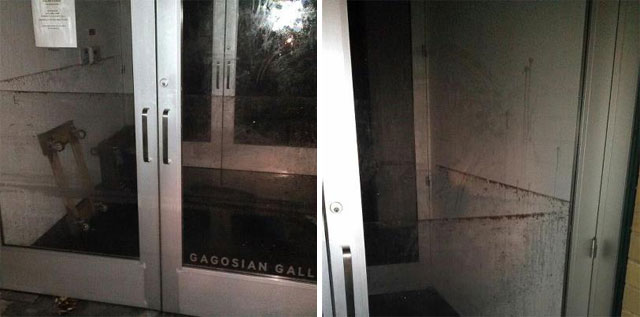At around 5:30 p.m. on Monday, Oct. 29, the Hudson River breached its banks near 20th Street. Cars were still driving down the West Side Highway and onlookers brought children to watch the river writhe in the approaching storm. Neighbors along the waterfront chatted casually, even as a storm of historical proportions threatened the cultural heartbeat that is New York City.
Blocks from the rising river, over two hundred galleries that comprise a core component of the art economy stood in "Zone A," a section that days before had been ordered to evacuate. While Sandy destroyed lives and homes, while bringing billions of dollars of damage throughout the tri-state area, the devastation to the art galleries in Chelsea has left the art world shaken and embittered. Within hours, the rising waters flooded basements and ground floors of almost every space in the neighborhood. By mid-week the crippling impact was well-reported by the arts and mainstream press alike: Some galleries lost entire storage rooms, nearly all had some structural flood damage, and thousands of art works were subject to triage. The financial hardship was so deep that some galleries are still unsure if they will be able to reopen.
AXA Art Insurance estimated the total damage to artwork at $40 million, which itself is only a base figure given that other firms assess the hit as well. This figure also does not take stock of the structural damage to the gallery spaces. In the wake of the storm, a rush of institutions reasserted flood damage and recovery protocols. The Museum of Modern Art and the American Institute for Conservation (AIC) hosted a consortium as a resource to the many collections that were in a state of chaos. The AIC provided the Collections Emergency Response Team (AIC-CERT) to educate those involved in the massive salvage of works. In addition to these efforts, the district may have to consider updating some basic assumptions, including flood-proofing methods of storage and a firm policy of making pre-storm adjustments to protect their inventory. One gallerist characterized the change in perspective: "Moving forward, we are always assuming the worst case scenario." It appears that, in stark contrast to museums, many commercial galleries did not observe disaster preparedness plans in the run-up to the storm. Further, comprehensive insurance that covers flood damage is not a priority for most spaces. With or without flood insurance, galleries can mitigate future damage by adopting preparedness and recovery strategies comparable to those used at museums.

Jomar Statkun, "Hyperallergic."
New York Governor Andrew Cuomo recognized that a postmortem assessment of Sandy's impact should include a "fundamental rethinking of our built environment." While Governor Cuomo is referring to the physical infrastructure of New York City -- utilities, roads and tunnels -- his words present an opportunity for art galleries to re-evaluate both their infrastructure and emergency preparedness.
The New York art community often feels untouchable, with its polished, urbane pretenses. The more physical tactics of storage and maintenance are among the least visible and least celebrated aspects of the business. Yet Sandy was a reminder not only of the realities of climate change but also of the physical vulnerability of the Chelsea spaces, which, after all, store and display objects of enormous historical and cultural value mere feet from the water's edge. The task ahead is to restore and then rebuild the vibrant cultural organism that is Chelsea, this time with a focus on investing in preventive measures.
By Cristina Tafuri. Read the original article as it appeared in Artwrit's November 2012 issue.